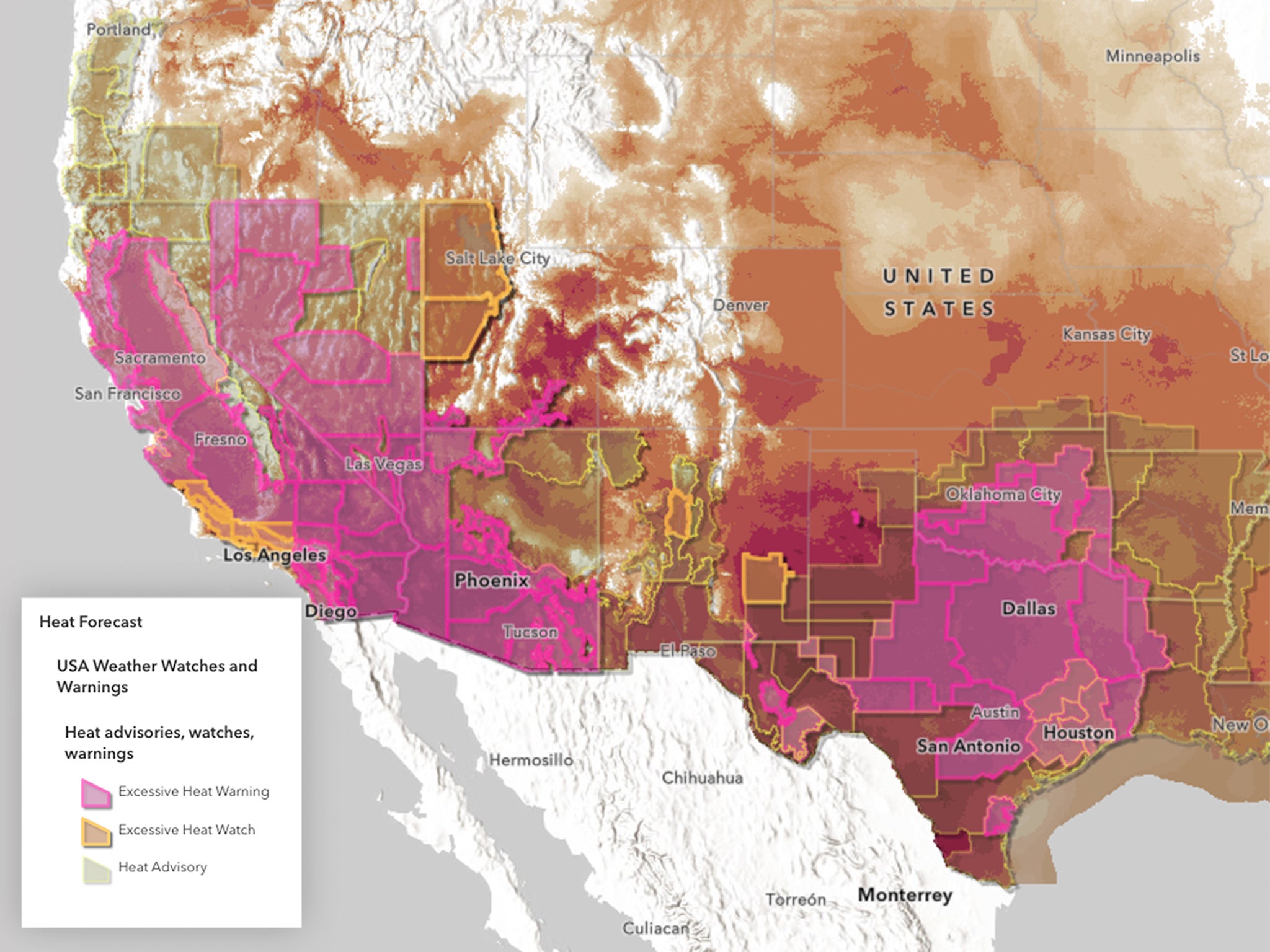More than 113 million Americans under extreme heat alerts as relentless temperatures continue
Relentless, hazardous heat is expected to continue for at least another week across parts of the south
More than 113 million Americans were under heat alerts on Thursday as stifling, life-threatening temperatures dug in across large parts of the country.
In the south and southeast, relentless, hazardous heat is expected to continue for at least another week after constant triple-digit temperatures in the past month.
A wide area will experience temperatures of 110 degrees Fahrenheit (43.3 Celsius), from a combination of heat and humidity, the National Weather Service reported.
The climate crisis, driven by the burning of fossil fuels, is making long-lasting, dangerous heat five times more likely in places like Texas, Arizona, and Mexico, according to analysis from Climate Central.
And there is little relief at nighttime as extreme heat in the Gulf of Mexico and Atlantic Ocean are contributing to prolonged humidity. The lack of nighttime cooling only increases the health risks, public health officials warned.
The mercury has hit 110F in Phoenix, Arizona for 13 days in a row as officials advised residents to limit outdoor activities, and be alert to signs of heat exhaustion and heat stroke. The risks of heat-related illness rise when the temperature surpasses 90F.
The city has opened a “heat relief network” to allow those without air conditioning to cool off at places like public libraries.

An intense heatwave is also building further west, and is likely to see temperature records topple this weekend, according to the National Weather Service (NWS).
Parts of California were warned to prepare for searing temperatures - the hottest of the year so far, NWS reported.
The most at-risk regions are California’s Central Valley, the Mojave and Sonoran desert regions, and southern California, Nevada, and Arizona including the cities of Las Vegas, Phoenix, Bakersfield and Fresno.
Midday highs were mostly expected to be above 100F (37.7 C), and desert areas could reach 120F (48.8 C), forecasters said.
“The heat will be extremely dangerous and potentially deadly due to the intensity, longevity, and a relatively cool start to summer that may have limited the ability for people to acclimate to more typical hot summer weather in this region,” forecasters said.
“Please plan accordingly, this is not the time to be hiking or be outside for long durations,” NWS’ Los Angeles office tweeted.
“If you need to work outside, shift hours to the early morning, take frequent breaks and hydrate!”
In California, the state reminded employers of health and safety regulations that mean outdoor workers are given water, shade and regular breaks to cool off. There are few protections for outdoor workers in other parts of the south including Texas.
The extreme heat and dry conditions were also increasing the wildfire risk in the Golden State with fire agency, Cal Fire, reporting a number of blazes have ignited since the beginning of July.

Europe is in the grip of a severe heatwave, named Cerberus, with temperature records broken in France, Switzerland, Germany and Spain.
On 11 July, the land surface temperature exceeded 140F (60C) in some areas of Extremadura, Spain while 13 communities remained at risk of temperatures surpassing 40C (104F).
This week, Greece introduced a mandatory work stoppage in the afternoon as temperatures topped 40C (104F).
Globally, June 2023 broke the temperature record by a significant margin, and the second week in July was the hottest ever recorded.
This has been combined with unprecedented sea surface temperatures and record low Antarctic sea ice.
Ocean temperatures in Florida, and other parts of the Gulf coast, have soared as high as 98 degrees in places this week, threatening to wipe out coral reefs.
The scorching heat is being driven by the rising global temperature as well as El Nino – a cyclic climate pattern which makes many places a lot hotter.
Join our commenting forum
Join thought-provoking conversations, follow other Independent readers and see their replies
Comments


Bookmark popover
Removed from bookmarks